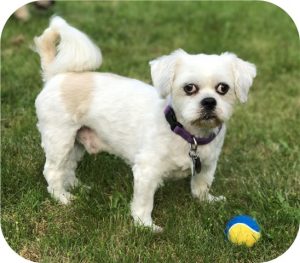Treating Anxiety in Dogs – Part 2
In my last blog I explained about anxiety in dogs using Kai, my now eight-year old shih tzu mix, as an example. I described how he was full of anxiety when I adopted him, and listed many of his anxious behaviors–being easily startled, hypervigilance (extremely vigilant), guarding toys from my other dog Danny, frequent barking that continued even after the “threat” ended, and trying to nip me when I petted him. Today I’ll explain how to help dogs overcome anxiety by telling you how I helped Kai.
Anxiety comes from the fear that something awful might happen that is more than we can handle. From Kai’s perspective all his anxious behaviors were attempts to prevent awful things from happening. My goal was to teach him that I would prevent them, and that I’d make sure he didn’t experience more than he could handle. My plan had three main components—a calm home, preventing anxious situations, and slow exposure to the petting he didn’t like.
First, since anger, loud noises, and yelling are intimidating to most living beings, I always tried to speak in a calm quiet voice. Sometimes that was challenging for me, but it was a crucial step if I truly wanted Kai to feel safe with me. Sometimes I slipped up, but for the most part I kept our home peaceful and calm.
Second, I figured out what situations made Kai anxious and tried to prevent them. By paying close attention I discovered that most of Kai’s anxiety came when he didn’t have control over his situation. My solution was to give him control over all the things I could. I didn’t pick him up unless I was certain he wanted that, I let him choose where we went on walks and how fast we went, and I didn’t try to interact with him unless he initiated it—I let Kai control when he got attention. That control over my attention allowed him to seek me out when he wanted contact, and to go chill out when he needed to. Often he liked to be in the same room with me but several yards away. At times I really wanted to go over to him or coax him to come to me, but I wanted to help him heal even more so I let him determine when we’d interact.
I couldn’t prevent all Kai’s anxiety-provoking situations, but I could help him predict some of them so they’d feel less threatening. For example, when I needed to put Kai’s water bowl down near him while he was eating, I approached him with heavy steps so he could hear them and feel the vibrations through the floor. When I reached him I spoke his name softly, and then lightly touched him on the shoulder. When I knew he was aware I was there, I put his water bowl down and then walked away. Another example is that when he came to me to be picked up, I counted to three out loud while I reached for him, and then counted to three before I lifted him off the ground. That way he could predict exactly when I would touch him, and exactly when he’d be suspended in mid-air. I also made sure I put him on the couch or floor very gently, and kept my hands on him for a moment after, so he didn’t feel like he was being dropped.
The third part of my plan was teaching him not to nip me when I petted him. To do that I used what psychologists call systematic desensitization—helping him gradually get used to what bothered him. I noticed that Kai tried to nip me after I touched him on his back—not when I first moved my arm, or when my hand was over him, but after I’d made firm contact with his back. The vet had said Kai was physically healthy and had no back problems, so I knew the nipping was part of his anxiety. My goal was to teach him that being touched on his back was no longer a bad thing. I worked on that whenever we sat together on the couch. Kai liked to sit next to me there as long as I didn’t pet him. Whenever he walked over to me and gave me the please-put-me-on-the-couch look, I’d pick him up and gently put him on the couch (counting 1-2-3 as I reached down to touch him, and 1-2-3 as I prepared to lift him from the ground into the air). He didn’t want attention while he was up there; he just wanted to lie next to me while I focused on something else. Although I really wanted to pet him I knew it would make his anxiety worse, so I respected his wish and kept my hands to myself. After 10-15 minutes of sitting together I calmly but quickly gave him a short pet on his back, then quickly took my hand away and returned to what I was doing. By the time Kai could turn around to nip me, my hand was already gone. Since I wasn’t trying to interact with him after the pet, Kai could gradually relax instead of experiencing the stress of dealing with me while he was already stressed from being touched. I did this routine only once each time we sat together. When I did it more often he would leave the couch, so I knew that one time was his limit.
After about a month of this Kai no longer tried to nip or snap at me when I gave him a pet on his back. At that point I started petting him twice before I quickly removed my hand. I did this once each time we sat together until he no longer tried to nip or snap at me. When we achieved this I considered that part of our program a success, and stopped. I respected Kai’s right to control when and how he was touched, and he had made it clear he didn’t like being petted on his back. He no longer nipped if I instinctively started to pet him, so there was no reason to put him through the stress of learning to accept more petting.
There were additional techniques I used while teaching Kai to overcome his anxiety, but the three I described here were the most important ones. I have to admit, though, that it didn’t go as smoothly as it sounds. At times progress was slow and uneven, and sometimes I got discouraged. However, I’m very persistent and I also really wanted to help Kai overcome his anxiety. We both slogged through it—Kai bravely and patiently put up with me even though he was afraid, and I consistently nudged him forward.
Today Kai rarely seems anxious. He loves to be petted and held, never tries to nip me, and sometimes tries to play with Danny. On the other hand, he is somewhat high-strung, still doesn’t like to be petted when we’re on the couch, (although he no longer nips), and growls if Danny comes close to a toy Kai likes. None of these quirks seriously interfere with his life, though. Kai has healed so much that I can confidently say that he is no longer an anxious traumatized dog.
If you have an anxious dog, I encourage you to try the techniques I described here. Both of your lives will be more enjoyable when you’ve moved beyond the anxiety.





